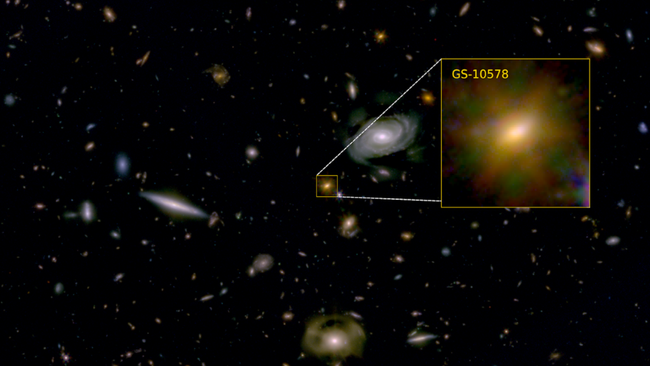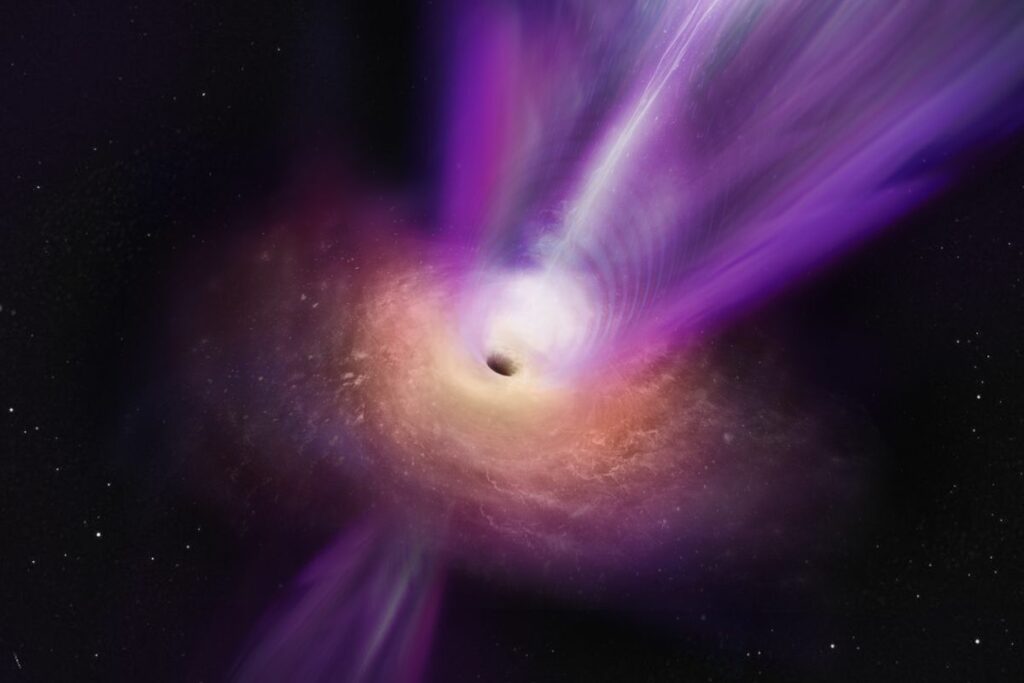James Webb Space Telescope Captures a Black Hole ‘Killing’ Its Galaxy (Photo)
“We found the culprit. The black hole is killing this galaxy and keeping it dormant by cutting off the source of ‘food’ the galaxy needs to form new stars.”

Scientists have captured what could be the youngest known supermassive black hole that is starving its galaxy and stopping it from making new stars, using JWST. This process called as “galactic death by starvation” appears to have taken place rather quickly with expulsion of gas in the speed of two million miles per hour.
The term “dead” or “quiescent” galaxies is used for galaxy where the formation of new stars has stopped, or has significantly slowed because the residuals of gas and dust – the material possibly containing of future stars is depleted. Astronomers have postulated for many years that supermassive black holes may be capable of ‘killing’ galaxies by ejecting these necessary star-forming materials.
Pablo’s Galaxy, located 11. Fortunately, they do not look at the AT 2018 location, which is 5 billion light-years away, through the lens of present-day eyes but as it seemed approximately 2. which became available 3 billion years after Big Bang. “We knew before that it was in a quenched state, that is, it was not forming many stars but was relatively large and we thought that there was some link between the black hole and the quenching of star formation,” said Francesco D’Eugenio of the Kavli Institute for Cosmology, Cambridge. “But until JWST, we could not study the galaxy in enough detail to verify the existence of the link, or to determine whether the quiescent state was temporary or permanent. ”
The galaxy which has a mass 200 billion Solar masses is approximately as large as the Milky Way and has assembled about twelve 5 and 11. 5 billion years concentrating many billions of baby stars than average this early in the evolution of The Universe.
“Most galaxies are forming stars in the early universe and thus it is rather surprising that we can see such a massive, non-star-forming galaxy during this epoch,” said Roberto Maiolino from the Kavli Institute. One has to note that the size of the galaxy and the fact of frozen star formation imply that the process must have occurred rather actively and quickly.

With the help of the JWST, the team found that the black hole residing in the nucleus of the galaxy Pablo’s Galaxy is expelling large quantities of gas that can travel at a speed of up to 2. 2 million miles per hour—1,:500 times faster than the maximum flight speed of Lockheed Martin F-16 jet fighter.
This gas speed is very important because it is of a rate at which the gas will be expelled out of this system of Galaxy of Pablo at autobiography hence out of pull of gravity. Most galaxies harboring ‘active,’ or ‘accreting,’ supermassive black holes have these fast-moving gas winds, but they are generally, low-mass ones, However, the JWST could detect a new component in Pablo’s Galaxy that previous telescopes had not been able to.
This component is composed of cooler, denser gas that produces little amount of light and that is why it was invisible to other equipment. JWST was able to get this dense gas because light from background galaxies was obscured by it, thanks to JWST’s high sensitivity.
The team further discovered that the amount of mass ejected by this AGN is far in excess of what the galaxy would require to spawn new stars, thus supporting the evidence that this supermassive black hole star is actually quenching galaxy star birth in this early universe galaxy. It is a fairly simple world, D’Eugenio went on to say ‘We’ve identified the culprit’. ”this black hole is starving this galaxy, swallowing the material that is required to make new stars.
There were thus several shocks in what JWST discovered even though the findings aligned with previous models on galaxy evolution and the role played by supermassive black holes in killing star formation. Theoretical models said that star formation would cease and this would cause disorder in the galaxy. However, stellar bodies in Pablo’s Galaxy seem to be ordered in their motion this may not always be the reality.
Subsequent to these JWST observations, the team also intends to observe Pablo’s Galaxy with ALMA in Chile to see if there are any cold and dense gas left over in this system and all the effects that the black hole has had on its environment.
Indeed, Maiolino said, “We have known for a long time that black holes greatly affect galactic structures, and probably halt star formation. ” “But until JWST nothing was so apparent, and it is one way which JWST is altering our vision of the early universe and how it grew. ”
The team’s research was published on Monday (Sept. 16) in the journal Nature Astronomy.
Do not forget to share your opinion with us to provide you with the best posts !



0 Comments